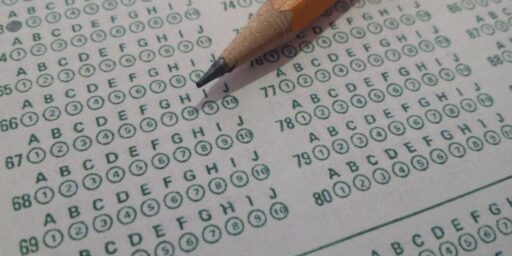States Omit Minorities’ School Scores
The misleading headline of the day comes from the AP: “States Omit Minorities’ School Scores.”
Laquanya Agnew and Victoria Duncan share a desk, a love of reading and a passion for learning. But because of a loophole in the No Child Left Behind Act, one second-grader’s score in Tennessee counts more than the other’s. That is because Laquanya is black, and Victoria is white. An Associated Press computer analysis has found Laquanya is among nearly 2 million children whose scores aren’t counted when it comes to meeting the law’s requirement that schools track how students of different races perform on standardized tests. The AP found that states are helping public schools escape potential penalties by skirting that requirement. And minorities — who historically haven’t fared as well as whites in testing — make up the vast majority of students whose scores are excluded.
Shocking, right?
The plight of the two second-graders shows how a loophole in the law is allowing schools to count fewer minorities in required racial categories. There are about 220 students at West View Elementary School in Knoxville, Tenn., where President Bush marked the second anniversary of the law’s enactment in 2004. Tennessee schools have federal permission to exclude students’ scores in required racial categories if there are fewer than 45 students in a group. There are more than 45 white students. Victoria counts. There are fewer than 45 black students. Laquanya does not.
One of the consequences is that educators are creating a false picture of academic progress. “We’re forcing districts and states to play games because the system is so broken, and that’s not going to help at all,” said Kathy Escamilla, a University of Colorado education professor. “Those are little games to prevent showing what’s going on.”
Under the law signed by Bush in 2002, all public school students must be proficient in reading and math by 2014, although only children above second grade are required to be tested. Schools receiving federal poverty aid also must demonstrate annually that students in all racial categories are progressing or risk penalties that include extending the school year, changing curriculum or firing administrators and teachers.
The law requires public schools to test more than 25 million students periodically in reading and math. No scores can be excluded from a school’s overall measure. But the schools also must report scores by categories, such as race, poverty, migrant status, English proficiency and special education. Failure in any category means the whole school fails.
States are helping schools get around that second requirement by using a loophole in the law that allows them to ignore scores of racial groups that are too small to be statistically significant. Suppose, for example, that a school has 2,000 white students and nine Hispanics. In nearly every state, the Hispanic scores wouldn’t be counted because there aren’t enough to provide meaningful information and because officials want to protect students’ privacy.
This isn’t so much a “loophole” but a planned feature. It’s actually rather silly to track how “Hispanics” are doing in a particular school when there are only nine of them. Not only would the privacy of those students be compromised but there simply are not enough of them to provide a statistically meaningful sample.
Overall, the AP found that about 1.9 million students — or about 1 in every 14 test scores — aren’t being counted under the law’s racial categories. Minorities are seven times as likely to have their scores excluded as whites, the analysis showed.
That’s probably because they’re minorities. Indeed, that one in seven of those excluded is white is surprising in a society that’s three quarters white.
Bush’s home state of Texas — once cited as a model for the federal law — excludes scores for two entire groups. No test scores from Texas’ 65,000 Asian students or from several thousand American Indian students are broken out by race. The same is true in Arkansas.
Remember, though, the law is designed to track how schools are doing, not states.And how many students attend Texas schools? Several million? Let me hazard a guess: The Asians are doing well as as group. The American Indians are not.
It’s not that the students are not being tested and monitored. They are. It’s just that their scores are not aggregated by race in cases where there is not a statistically meaningful number of students in that racial grouping in a particular school.
Students whose tests aren’t being counted in required categories also include Hispanics in California who don’t speak English well, blacks in the Chicago suburbs, American Indians in the Northwest and special education students in Virginia.
Why one would include special ed students–if by that they mean retarded rather than gifted children–in the measure is beyond me. They are, by definition, going to do poorly. And students who don’t speak English are hardly the school’s fault, let alone an indication of how well the school is teaching its kids. The other groups, presumably, are simply too small in those localities.
Bush has hailed the separate accounting of minority students as a vital feature of the law. “It’s really essential we do that. It’s really important,” Bush said in a May 2004 speech. “If you don’t do that, you’re likely to leave people behind. And that’s not right.”
Of course. But it’s not right to try to draw statistical inference from tiny samples. That’s why the law has this “loophole.”






If minorities are 7 times more likely to be excluded than whites, then 1 in 8 of those excluded are white, not 1 in 7.
I only took one course in statistics and even I understand why these exclusions are being made.
If this is any indication, the two or three journalism courses I took ought to make me a better news reporter than 83%* of the profession.
*Ironically, this figure is exactly the same as the percentage of rhetorical statistics that are made up on the spot.
The next headline:
No understanding of sample size: women, minorities hardest hit
It’s not that “small” groups of minorities are going unreported – it’s that the school systems themselves, with help from state ed. departments, are the ones defining what “small” means.
Hell, if I was given the authority to define what a “charitable donation” on my tax form is, I’m gonna define it to include everything I pay to support my family, ’cause they’re my biggest charity, right?
That’s why I don’t get to define “charity”, and why the schools being measured shouldn’t get to define “statistically insignificant”.
I live in a state that is about 99% white. You could easily go a whole day and not see a single minority in most situations.
We just got my kids’ scores back from their state testing (and yes the scores for the district were terrible, although my kids did fine). The important thing to note is 1-the minority children are not being exempted from the testing, the test scores of the minority children come back to the school and they see and monitor that child’s proggress and 2 if the sample size is too small, then any results are statistically insignificant.